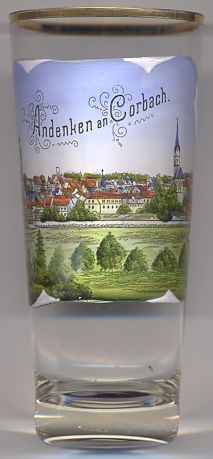

|
| DEUTSCHLAND | GERMANY |
| Bundesland: Hessen | Hesse |
| Regierungsbezirk: Kassel | |
| Landkreis: Waldeck-Frankenberg |
 Korbach is sitated at an elevation of 384 m on an elevated plateau at the northeastern slopes of the
Rhenish Slate Mountains (Rheinisches Schiefergebirge) of northern Hesse. In 1970/1971 fourteen neighbouring
communities were incorporated into the municipality that today has a population of about 24,500 (2004).
Since 1974 Korbach is the administrative seat of the district Waldeck-Frankenberg.
Korbach is sitated at an elevation of 384 m on an elevated plateau at the northeastern slopes of the
Rhenish Slate Mountains (Rheinisches Schiefergebirge) of northern Hesse. In 1970/1971 fourteen neighbouring
communities were incorporated into the municipality that today has a population of about 24,500 (2004).
Since 1974 Korbach is the administrative seat of the district Waldeck-Frankenberg.
Already before AD 800 Korbach was the site of a Karolingian royal residence. The oldest written mention of Curbechi dates from 980 and is found in a document confirming the donation of Korbach to the monastery of Corvey (see Höxter). In 1188 the bishops of Paderborn granted Korbach the privileges of a town according to the municipal laws of Soest. The town soon flourished as it was situated on the crossroads of the important trading routes from Cologne to Leipzig and from Frankfurt am Main to Bremen. In the 14th century, two new communities, Obere and Untere Neustadt (upper and lower new town), were founded outside the old town (Altstadt). The new town was merged with the old town in 1377. In 1469 Korbach was mentioned as a member of the Hanse federation of trading towns for the first time. It is thus the only town in Hesse that had been a member of the Hanse. During the Thirty Years' War (1618–1648) the town suffered heavily; after the war, only about half of the former population was left. In addition, a large fire destroyed large parts of the town in 1664. It took until the 18th century that the town recovered. A new flourishing period began in the late 19th century, especially after the opening in 1893 of the railroad to Kassel. Luckily, Korbach did not suffer major damages during the two World Wars. Most parts of the historic old town with its medieval double ring of town walls are still well preserved.
The  Protestant church of Sankt Nicolai [background right],
the parish church of the new town, was built in Gothic style between 1359 and 1450 in place of an older chapel.
Protestant church of Sankt Nicolai [background right],
the parish church of the new town, was built in Gothic style between 1359 and 1450 in place of an older chapel.
![[scale]](lineal.jpg)